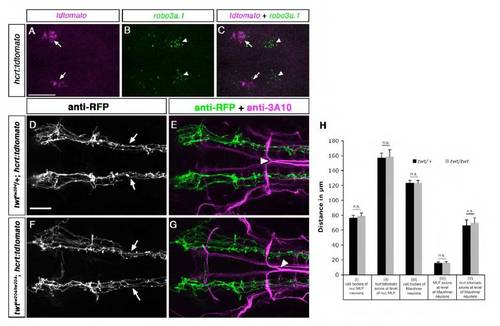Fig. S6
- ID
- ZDB-FIG-130123-48
- Publication
- Schweitzer et al., 2013 - Sim1a and Arnt2 contribute to hypothalamo-spinal axon guidance by regulating Robo2 activity via a Robo3-dependent mechanism
- Other Figures
- All Figure Page
- Back to All Figure Page
|
robo3 is not required for HTS longitudinal tract formation of Hcrt neurons. Dorsal views of confocal z projections of the brain of 24 hpf embryos (A-C) or hindbrain of 72 hpf embryos are shown. Anterior is towards the left. (A-C) Whole-mount fluorescent in situ hybridization for tdtomato and robo3a.1 expression in hcrt:tdtomato embryos are shown. robo3a.1 (arrowheads in B,C) was not detectable in Hcrt neurons (arrows in A,C). (D-G) Immunohistochemistry with anti-RFP and anti-3A10 antibodies demonstrates that pathfinding of TdTomato-positive longitudinal axons is similar in twttw204/+;hcrt:tdtomato (arrows in D) when compared with twttw204/+;hcrt:tdtomato embryos (arrows in F). Arrowheads in E indicate normal midline crossing of Mauthner axons in heterozygous robo3 embryos; arrowhead in G denotes abnormal crossing of Mauthner axons in homozygous robo3 mutants. (H) Quantification of the distance between nucMLF neurons (I) and MLF axons (III), hcrt:tdtomato longitudinal axons at two different positions (II +IV) and MA neurons (V) in twt/+ and twt/twt embryos. n.s., not significant. Scale bars: in A, 50 μm for A-C; in D, 50 μm for D-G. |

